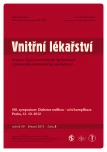What has the largest study in the history of diabetology brought us?
Authors:
Z. Rušavý 1; S. Lacigová 1; M. Kvapil 2
Authors‘ workplace:
I. interní klinika Lékařské fakulty UK a FN Plzeň, přednosta prof. MUDr. Martin Matějovič, Ph. D.
1; Interní klinika 2. lékařské fakulty UK a FN Motol Praha, přednosta prof. MUDr. Milan Kvapil, CSc., MBA
2
Published in:
Vnitř Lék 2013; 59(3): 160-164
Category:
Review
Overview
The main objective of the ORIGIN study was an observation of the effects of treatment with insulin analogue, insulin glargine on cardiovascular complications in patients with severe atherosclerosis and early stages of well-compensated diabetes and prediabetes. The authors expected that a long-term reduction of glycaemia on an empty stomach will reduce the number of occurrences of cardiovascular complications. The study, which was conducted over a period of more than six years, showed neither a positive nor a negative effect of insulin treatment on cardiovascular complications. The second main objective of the study was the following: to compare the effect of the ω-3 fatty acid treatment versus placebo on the development of cardiovascular complications. However, no influence of n-3 fatty acids on the development of cardiovascular complications was found. The study investigated whether the insulin glargine treatment leads to an increased number of cancer occurrences. No correlation between cancer and the insulin glargine treatment was proven in this study. Long-term insulin treatment in the early stages of diabetes led to a minimal increase in weight through the course of six years (1.5kg) and to three times more hypoglycaemia occurrences compared to placebo. However, the number of hypoglycaemia occurrences was very small.
Conclusion:
The study has confirmed the safety of the insulin glargine treatment combined with metformin in the early stages of diabetes, without an increased number of atherosclerosis or cancer occurrences, and with minimal weight gain.
Key words:
diabetes mellitus – glargine – cardiovascular complications – prediabetes – ω-3 fatty acid treatment – hypoglycaemia
Sources
1. Patel A. ADVANCE Collaborative Group. Intensive blood glucose control and vascular outcomes in patients with type 2 diabetes. N Engl J Med 2008; 359 : 2560–2572.
2. Duckworth W, Abraira C, Moritz T et al. Intensive glucose control and complications in American veterans with type 2 diabetes. N Engl J Med 2009; 360 : 129–139.
3. The Action to Control Cardiovascular Risk in Diabetes Study Group. Effects of intensive glucose lowering in type 2 diabetes. N Engl J Med 2008; 358 : 2545–2559.
4. Charvat J, Michalova K, Chlumsky J et al. The significance of carotid artery plaques in the detection of coronary artery disease in asymptomatic type 2 diabetic patients. J Int Med Res 2006; 34 : 13–20.
5. The ORIGIN trial investigators. Basal insulin and cardiovascular and other outcomes in dysglycemia. N Engl J Med 2012; 367 : 319–328.
6. The ORIGIN trial investigators. N-3 Fatty Acids and Cardiovascular Outcomes in Patients with Dysglycemia. N Engl J Med 2012; 367 : 309–318.
7. The Emerging Risk Factors Collaboration. Diabetes mellitus, fasting blood glucose concentration, and risk of vascular disease: a collaborative meta-analysis of 102 prospective studies. Lancet 2010; 375 : 2215–2222.
8. Stratton IM, Adler AI, Neil HA et al. Association of glycaemia with macrovascular and microvascular complications of type 2 diabetes (UKPDS 35): prospective observational study. BMJ 2000; 321 : 405–412.
9. Rhoads GG et al. Comparison of incidence of acute myocardial infarction in patients with type 2 diabetes mellitus following in 1753-itiation of neutral protamine Hagedorn insulin versus insulin glargin. Amer J Cardiol 2009; 16 : 910–916.
10. Weng J et al. Effect of intensive insulin therapy on beta cell function and glycaemic control in patients with newly diagnosed type 2 diabetes: a multicentre randomised parallel-group trial. Lancet 2008; 371 : 1760–1764.
11. Retnakaran R, Zinman B. Short term intensified insulin treatment in type 2 diabetes: long term effects on beta cell function. Diab Obes Metabolism 2012; 14: (Suppl. 3): 161–166.
12. Harrison LB, Adams-Huet B, Raskin P et al. Beta-cell function preservation after 3,5 years of intensive diabetes therapy. Diab Care 2012; 35 : 1406–1412.
13. Marchioli R, Barzi F, Bomba E et al. GISSI--Prevenzione Investigators: Early protection against sudden death by n-3 polyunsaturated fatty acids after myocardial infarction: time-course analysis of the results of the Gruppo Italiano per lo Studio della Sopravvivenza nell‘Infarto Miocardico (GISSI)-Prevenzione. Circulation 2002; 105 : 1897–1903.
14. Kromhout D, Giltay EJ, Geleijnse M for Alfa Omega Trial Group. N-3 Fatty Acids and Cardiovascular Events after Myocardial Infarction. N Engl J Med 2010; 363 : 2015–2026.
15. Filion KB, El Khoury F, Bielinski M et al. Omega-3 fatty acids in high-risk cardiovascular patients: a meta-analysis of randomized controlled trials. BMC Cardiovascular Disorders 2010; 10 : 24.
16. Inzucchi SE et al. Management of hyperglycemia in type 2 Diabetes: A Patient-Centred Approach. Diabetes Care Publish Ahead of Print online April 19, 2012.
Labels
Diabetology Endocrinology Internal medicineArticle was published in
Internal Medicine

2013 Issue 3
Most read in this issue
- Diabetic nephropathy/diabetic kidney disease
- Treatment of diabetic macular oedema
- Progression of diabetic retinopathy in pregnancy
- Patophysiology of diabetic retinopathy
